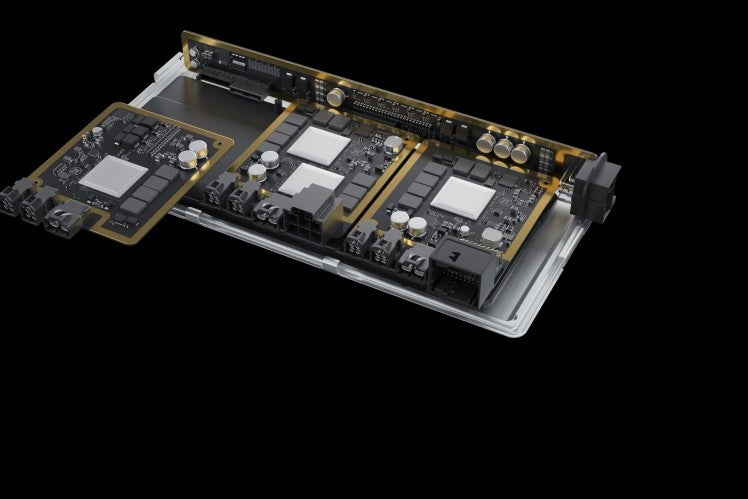
German automotive components manufacturer ZF Group and Chinese technology firm Horizon Robotics have announced that they plan to launch a jointly developed advanced driver assistance system (ADAS) for the Chinese market, with mass production scheduled for 2026.
ZF has also confirmed that the new ADAS system will support up to SAE Level 3 automated driving and will feature China’s urban “Navigation on Autopilot” (NOA). It will initially be applied to a battery electric vehicle (BEV) platform produced by an unnamed Chinese vehicle manufacturer.

Discover B2B Marketing That Performs
Combine business intelligence and editorial excellence to reach engaged professionals across 36 leading media platforms.
ZF has hailed the move as a significant breakthrough in its localisation strategy in China in the field of intelligent driving. The ZF ProAI automotive-grade computing platform will feature Horizon Robotics’ Journey 6P processing hardware, with a computing power of up to 1,000+ TOPS – enough – it is claimed – for “full-scenario assisted driving.”
We hear from Dr. Christian Brenneke, Head of ZF’s Electronics & ADAS division, to learn more.

What is the background to ZF in China?
China is an innovation ‘homeroom’ and ‘gym’ for the global automotive industry and is also ZF’s most important strategic automotive market. Close cooperation with Horizon Robotics and Chinese-branded automakers allows us to more accurately grasp market trends, integrate globally leading technologies with local application scenarios, and provide customers with high-value products that combine technological advancement and market adaptability.

US Tariffs are shifting - will you react or anticipate?
Don’t let policy changes catch you off guard. Stay proactive with real-time data and expert analysis.
By GlobalDataWhat about the partnership with Horizon Robotics? What is the rationale there?
ZF and Horizon Robotics have decided to use the advantages of both sides to quickly bring new technologies and local solutions to market; the first cooperation is on Horizon Robotics’ J6P SoC processing hardware as a starting point.
Could you explain the ProAI platform, how it works, what it is able to achieve?
To ensure the safe and real-time calculation of these functions, future vehicle architectures will necessitate increasing computing power. The ProAI family from ZF is an automotive-grade central computer suitable for all vehicle platforms, software applications, and E/E-architectures. A high-performance version of ProAI went into series production at the end of 2024. Several other versions – for example, for ADAS cameras and parking solutions – had already entered series production prior to this.
In addition to the ProAI versions already established, ZF is expanding its product portfolio and can now offer more cost-effective compute units for volume models under the ProAI name. Thanks to the scalability and modularity of ProAI, this is a logical step toward a clearly structured product offering: ProAI can be configured individually and as required for all vehicle classes, types, and architectures – from low-cost entry-level models for pure front camera solutions or parking-only applications to powerful comfort configurations for Level 2+ and Level 3 ADAS and chassis solutions in the premium segment, right through to all-in-one supercomputers that control entire autonomous applications. This makes “ProAI” synonymous with automotive compute solutions at ZF.

The highest configuration level is a multi-domain capable edition with multiple performance boards and a computing power of more than 1,500 TOPS (1.5 quadrillion computing steps per second). These performance boards can be individually equipped with microprocessors from all major manufacturers and different operating systems, thus ensuring the maximum possible flexibility and freedom when developing new architectures with centralized design.
This version of ProAI can serve different domains in the vehicle in “one box” – for example ADAS/AD, chassis and in-vehicle infotainment (IVI). This solution offers unparalleled options in flexibility and a wide range of planning and design options for software-defined vehicles with centralized E/E architecture.
This platform targets SAE L3 assistance functions. In this case, the function is developed internally by the customer.
What features will be available for drivers?
This platform targets SAE L3 assistance functions. In this case, the function is developed internally by the customer. So this platform aims to implement SAE Level 3 assistance systems for use on both highways and in urban traffic.
What is the timeline for development and when will this technology become more widespread?
Scheduled for mass production and delivery in 2026, the system will be applied to an electric vehicle platform of a Chinese automobile brand. Given this product is capable to support SAE Level 3, we expect that Level 3 will soon become more widespread in China and worldwide as technology and regulations continue to evolve.



